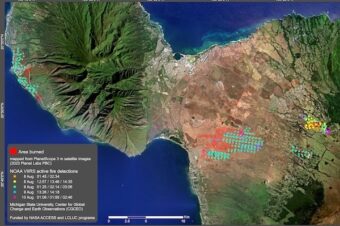The Tibetan Plateau is blooming later than it did 30 years ago.TAO Images Limited / Alamy
In many regions, climate change has advanced the timing of spring events, such as flowering or the unfolding of leaves. But the meadows and steppes of the Tibetan Plateau are bucking that trend — plants are starting to bloom later in spring, making the growing season shorter. This change could threaten the livelihood of the thousands of nomads who survive by raising cattle on the plateau.
“I’ve worked in the Tibetan Plateau region for 25 years,” says Jianchu Xu, an ethnoecologist at the World Agroforestry Centre in Kunming, China, and a professor at the Kunming Institute of Botany of the Chinese Academy of Sciences, who led the study, published this week in the Proceedings of the National Academy of Sciences1. Xu says he expected that plants on the plateau would follow the same pattern of early flowering seen elsewhere. In Europe, for instance, spring flowerings in 2000 occurred about 8 days earlier than they did in 1971 on average, and autumn events, such as changes in leaf colour, about 3 days earlier2.
“But then my PhD student Haiying Yu looked at more recent data” and discovered that the opposite was the case. The finding “contradicted the linear link” that is often seen between warming temperatures and an earlier start to the growing season, Xu says.
Land for grazing may be in short supply in future.Jianchu Xu
The group used satellite data to identify the start, end and length of the growing season for the meadow and steppe vegetation of the Tibetan Plateau between 1982 and 2006, and linked it to temperature change. During this time, the mean temperature rose about 1.4 ºC on the steppes and 1.25 ºC on the lower-lying meadows.
The study showed an initial advance in the timing of the growing season or its ‘phenology’ for both the meadow and steppe for the first 15 years. But from 2000 until 2006 that trend was reversed. The net effect was a shortening of the growing season by about one month for steppe plants and three weeks for meadow vegetation.
Grass impasse
Plants that have evolved in cold-weather climates become dormant in the winter to avoid frost damage. But the warmer winters on the plateau are delaying spring growth, the authors say, because plants are not meeting their chilling requirements — a minimum period of time that plants must experience cold before they break winter dormancy.
“The idea has been out there, but I don’t think very many people would have expected to see this sort of reverse response to warmer spring this soon,” says Arthur Weis, an evolutionary biologist at the University of Toronto, Ontario.
Martin Lechowicz, a plant ecologist at McGill University in Montreal, Quebec is not surprised, however. Lechowicz and his colleagues have analysed and modelled the timing of leaf-bud burst in 22 North American tree species throughout the twenty-first century3. Almost all species showed earlier bud burst, but some had years of abnormal bud-burst timing because they had not chilled enough over the winter. “Many models of climate change’s effects on the growing season don’t deal with the internal climate-control system by which plants respond to seasonal temperature changes,” says Lechowicz.
ADVERTISEMENT
news@nature.com/;sz=300×250;ord=’ + ord + ‘?”>’); document.write(‘
news@nature.com/;sz=300×250;ord=’ + ord + ‘?” border=”0″ height=”250″ width=”300″ />’); } //–>
The Tibetan alpine meadow grassland is used by local people to graze their yaks and sheep. “The change in the growing season may mean there is less grassland biomass available for grazing,” says Xu. “They will have to come up with local adaptive strategies to make sure the animals have enough grazing land.”
“Although I’m not surprised, it is very interesting,” says Lechowicz, But more detailed data would be useful, he says. “It would be nice to put people on the ground and have them do a species-by-species tracking. That would help resolve what is going on in the plant communities.”
Xu says he has plans to study the reaction to warmer winter temperatures at the species level to understand the phenology changes in detail — and perhaps suggest possible strategies for dealing with diminishing opportunities for nomads grazing their animals on the plateau.
Paul Garrett Hugel
Technology Test Pilot
ORCID iD: 0000-0001-8082-7208 Paul Garrett Hugel on BlueSky @paul.nko.org
Latest posts from Paul Garrett Hugel
- Privacy-Preserving Data Collaboration: OpenMined Overview - November 16, 2025
- 🚨 The “No Kings” Protests: - October 18, 2025
- Environmental Groups Condemn EPA Plan to Rescind 2009 Climate Finding - July 29, 2025
Recent Posts
Privacy-Preserving Data Collaboration: OpenMined Overview
Unlocking Secure Data Collaboration: A Technical Introduction to OpenMined 1. How Privacy-Preserving Data Collaboration Solves... Read More
🚨 The “No Kings” Protests:
This week, something historic happened: nearly seven million people across 40+ countries marched against Donald Trump’s administration... Read More
Environmental Groups Condemn EPA Plan to Rescind 2009 Climate Finding
Executive Summary On July 29, 2025, EPA Administrator Lee Zeldin announced the agency’s intent to rescind the 2009... Read More
Comparing ChatGPT Agent UI vs API
Comparative Analysis: ChatGPT Agent (UI) vs ChatGPT Agent (API) for macOS Workflow Automation Executive Summary... Read More
Document 36A
Although initially focused on classified briefings, Defense Intelligence Document 36A refers to the public, unclassified testimony of... Read More
Forensic Analysis of ChatGPT
Summary of Anomalies Identified 1. Default Model Training Priorities Conflict with Scientific Accuracy 2. Memory... Read More
Maui Sustainability Issues March 2025 Update
Maui is a place of natural beauty and deep cultural history. But today, the island... Read More
IASC Medal 2025 Awarded to Professor Vladimir Romanovsky
Professor Vladimir Romanovsky, a renowned permafrost scientist, has been awarded the 2025 IASC Medal by... Read More







